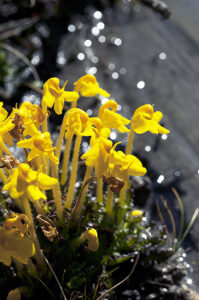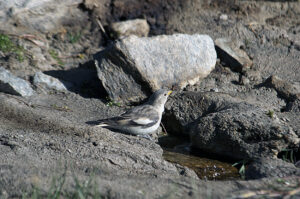Kaj Halberg - writer & photographer
Travels ‐ Landscapes ‐ Wildlife ‐ People
The dry Tibetan Plateau


A word, which conjures up pictures of wind-blown mountain passes with stone cairns, adorned with hundreds of fluttering Buddhist prayer flags; of Tibetan wild asses (Equus kiang), grazing on a meadow among countless red primroses and yellow louseworts; or perhaps of Swedish explorer Sven Hedin (1865-1952), who was the first European to explore the area around the sacred Mount Kailas in western Tibet – the physical manifestation of the mythical mountain Meru and an important pilgrimage destination for followers of three religions: Hinduism, Buddhism, and Jainism.
Transhimalaya, which literally means ’on the other side of the Himalaya’, consists of two mountain ranges, Gangdise and Nyenchen Tanglha, altogether stretching c. 1,600 km across the southernmost part of the Tibetan Plateau, parallel to the Himalaya. In daily speech, though, the word includes the entire plateau.
The high peaks of the Himalaya act as a wall, causing the major part of the monsoon precipitation to fall, before the wind reaches the high plateau. In Ladakh, for instance, the annual precipitation is less than 100 mm. Most of this dry, desert-like habitat lies within Tibet, but reaches into northern Pakistan, northern Bhutan, in Nepal into the regions of Humla, Dolpo, Mustang, and Manang, and in India into Ladakh, the northern half of Himachal Pradesh, and northernmost Sikkim and Arunachal Pradesh.
Most plant genera of the Tibetan Plateau are also found in the Himalaya. However, some genera are unique to the area, adapted to the dry climate. Most of the plant species mentioned on this page are dealt with in detail on the page Plants: Himalayan flora.
Within a fairly small area of Ladakh, you are able to experience numerous facets of the Tibetan landscape, displaying a characteristic selection of the plateau vegetation, combined with a fascinating and relatively intact Buddhist culture. In July, when blooming is at its peak, a number of interesting hikes can be made in this area, among these a two-week-trek, starting out from the village of Lamayuru, c. 125 km west of Leh, the main city of Ladakh. Initially, on this route, you must climb two high passes, Konze La (4905 m) and Dundunchen La (4800 m), after which you cross the Zanskar River into the fairly fertile Markha Valley. The final obstacle is a very high pass, Kongmaru La (5274 m), from where you follow the Sumdo River down to Hemis Gompa, south-east of Leh.
Lamayuru has a spectacular location beneath eroded crags, above which a huge gompa (a Tibetan Buddhist monastery) has been erected. The landscape is sprinkled with chortens, the Tibetan counterpart of the Indian stupa – a domed building, which often contains religious relics, such as bones of a monk or another holy person.
Chortens are an integrated part of Tibetan Buddhism, or Lamaism. Long rows of piled stone slabs often lead out from these chortens, carved with innumerable Buddhist mantras. These slabs are called mani stones, a name that stems from the most common inscription on them, Om Mani Padme Hum. Mani Padme loosely translates as ’jewel in the lotus flower’ – a picture of the Buddha – whereas Om and Hum are intensifying mantra words. You may read more about chortens, mani stones, and other aspects of Lamaism on the page Religion: Buddhism.
At chortens and on mani walls, locals often place yak horns or horns from wild sheep or goats, painted red. These horns are a trace of the ancient, pre-Buddhist religion Bon, in which the ox was worshipped. This ancient belief is described on the page Religion: Animism.



Rivers criss-cross the plateau, but between the streams are huge areas without permanent water. On these plains, and on mountain slopes, the vegetation is adapted to the dry conditions. Prickly or spiny shrubs are ubiquitous, including a milk-vetch, Astragalus strictus, a yellow-flowered legume, Caragana versicolor, a honeysuckle, Lonicera spinosa, and the beautiful Rosa webbiana. Other shrubs include common caper (Capparis spinosa), various junipers (Juniperus) and joint-pines (Ephedra), two dwarf rhododendrons, R. nivale and R. cephalanthus, and Tibetan shrubby cinquefoil (Dasiphora dryadanthoides).
Herbs in dry areas include a locoweed, Oxytropis microphylla, a hedge-nettle, Stachys tibetica, a stonecrop, Rosularia alpestris, the yellow-flowered Arisaema flavum, of the arum family, and Lindelofia stylosa, of the forget-me-not family. Stellera chamaejasme is a low plant of the daphne family, with pretty white inflorescences. It is very common, as grazing animals avoid it. This species is utilized in traditional medicine to treat asthma, skin problems, and internal parasites. Paper can be made from its roots.
As a means of protection against the strong winds, which often blow up here, the leaves of certain plant species are hugging the ground, including a blue-flowered member of the mint family, Phlomoides rotata, and the yellow-flowered Oreosolen wattii, of the figwort family. Other species protect themselves against wind and evaporation by forming compact cushions, including prickly thrift (Acantholimon lycopodioides), of the sea-lavender family, and Thylacospermum caespitosum, of the carnation family.
Where rocky slopes have been eroded to gravel, a catmint, Nepeta floccosa, and a globe thistle, Echinops cornigerus, are very common, and in cracks among rocks you may observe Corydalis moorcroftiana, two members of the trumpet-creeper family, Incarvillea mairei and I. younghusbandii, and others.









Several species of pika (Ochotona) live on the plateau. These small animals resemble large voles, but are in fact relatives of hares and rabbits. In their deserted dens, the small, sand-coloured Hume’s ground-tit (Pseudopodoces humilis) often breeds. Formerly, this bird was placed in the crow family, but recent DNA research has shown that it is a close relative of the European great tit (Parus major), and some authorities even name it Parus humilis.
As their name implies, toad-headed agamas have toad-like heads. With a bit of luck, you may observe Theobald’s toad-headed agama (Phrynocephalus theobaldi), which often presses its body firmly to the ground to escape notice. On the other hand, red-spotted agamas (Laudakia himalayana) and a skink, Scincella ladacensis, are easily observed on exposed rocks, basking in the sun.



In meadows along rivers and lakesides grasses dominate the vegetation, together with sedge (Carex) and other members of the sedge family, such as Kobresia. Common species also include a pink primrose, Primula tibetica, various species of edelweiss (Leontopodium) and knotweed (Bistorta, Persicaria, Koenigia), long-tubed lousewort (Pedicularis longiflora), and another yellow-flowered lousewort, P. bicornuta.
In non-cultivated valleys, the river banks are often hidden under dense shrubs of various bushes, including willows (Salix), a species of false tamarisk, Myricaria elegans, and Tibetan sea-buckthorn (Hippophaë tibetana). Large areas are also covered in huge growths of Himalayan balsam (Impatiens glandulifera), which, incidentally, is an invasive weed in many parts of Europe, expelling native plants. Other common river species include a white windflower, Anemone rivularis, a pale-blue columbine, Aquilegia moorcroftiana, a yellow corydalis, Corydalis flabellata, and the pretty Codonopsis clematidea, of the bellflower family.
Tibetan lakes are breeding places for a number of birds, including Mongolian plover (Charadrius mongolicus), ruddy shelduck (Tadorna ferruginea), and bar-headed goose (Anser indicus). Well-known European birds like redshank (Tringa totanus) and great crested grebe (Podiceps cristatus) are also encountered. Bird-rich lakes include Tso Moriri and Tso Kar in Ladakh.
High-altitude lakes and marshes are also breeding habitat of the beautiful black-necked crane (Grus nigricollis), which is restricted to the Tibetan Plateau. In the 1950s, this species began to decline drastically due to draining of wetlands and overgrazing by goats, sheep and cattle. Conservation efforts have since caused the population to slowly increase, and today it may count as many as 10.000 birds.
In 1950, members of the Third Danish Central Asian Expedition carried out a great deal of research around Tso Moriri. From his results of mapping folding structures of the mountains in this area, Danish geologist Asger Berthelsen made the conclusion that Alfred Wegener’s theory of continental drift, from 1912, in all probability was correct – a fact, which later research has confirmed.








Like prickly thrift, mentioned above, the leaves of several alpine species also form compact cushions, from which tiny flowers peep out, among others Thylacospermum caespitosum and a sandwort, Arenaria bryophylla, both of the carnation family, and a rock-jasmine, Androsace tapete, of the primrose family.
Among scree at the foot of the mountains, you may encounter Himalayan marmot (Marmota himalayana), often sitting on its haunches outside its den. If you approach too close, it will emit a sharp warning call. Flocks of blue sheep, or bharal (Pseudois nayaur), and Siberian ibex (Capra sibirica) live on the mountain slopes. Their only enemies (besides Man) are snow leopard (Uncia uncia) and Himalayan wolf (Canis himalayensis). Passerines like rufous-breasted accentor (Prunella rubeculoides) and Tibetan snowfinch (Montifringilla adamsi) are often very tame. Several species of Apollo butterflies (Parnassius) may also be observed at this altitude.






